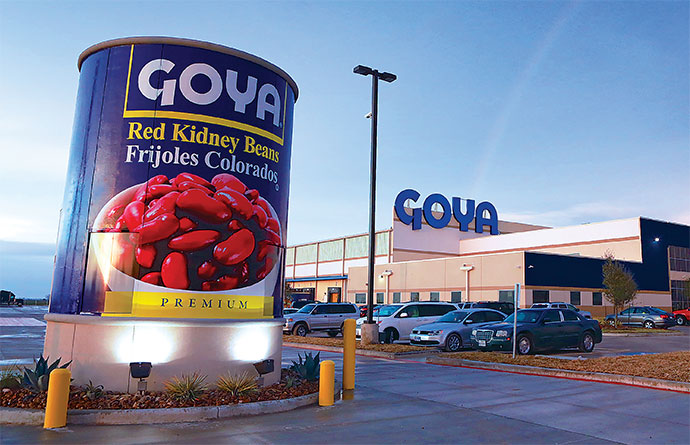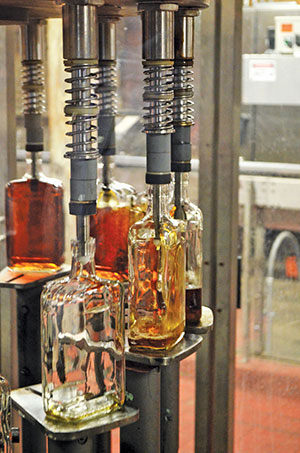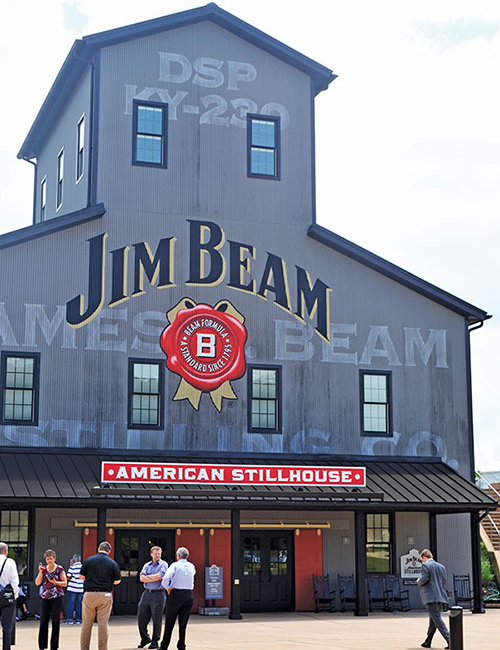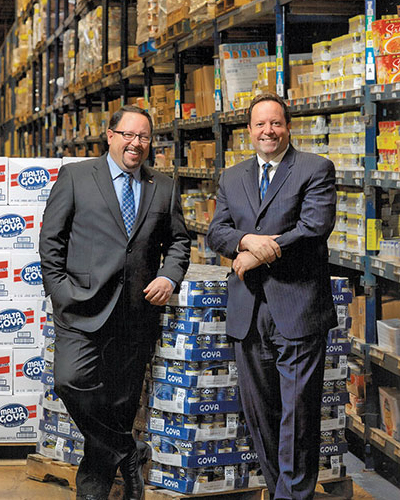Americans craving ethnic food is one of the top factors driving corporate site selection in the food-processing sector today.
From the battle to land Sriracha hot sauce maker
Huy Fong Foods to the aggressive expansion strategy of Latino cuisine producer
Goya Foods, the US is experiencing a surge in ethnic food-processing plant investment – and this expansion wave is not expected to subside anytime soon.
According to Jay Garner, president and founder of Garner Economics in Atlanta, ethnic food-processing expansion is one of 10 trends shaping the growth and development of the food and beverage industry in the US today. The others, the noted site selection consultant says, are as follows:
- Growth in the organic food sector.
- Ready-to-eat meals production.
- Supermarket chains like Publix and Kroger creating their own private-label brands.
- “Substantial growth in cold storage facilities,” primarily located at import and export sites.
- Higher and higher ceiling heights for distribution facilities.
- Increasing equipment costs to the point that equipment can now cost more than the building.
- Scarcity and distribution of water.
- Access to both the commodity and the customer as the key drivers. “That is why you can never discount California,” says Garner.
- Food safety.
“The most growth by far of any sector that we are seeing right now is in the ethnic foods sector, primarily Hispanic cuisine,” says Garner. “People simply can’t get enough Latino foods these days, and this is driving a lot of new corporate site selection in food processing.”
A case in point is Goya Foods, the largest Hispanic-owned food company in the US. On March 27, the Secaucus, N.J.- based company announced it was opening four new state-of-the-art manufacturing, production and distribution facilities in California, Georgia, New Jersey and Texas as part of a $250-million global expansion.
“With the growing Hispanic population and the need for good nutrition, it’s an opportune time for Goya to expand,” said Bob Unanue, president of Goya Foods.
Access to Global Markets
The new 350,000-sq.-ft. (32,515-sq.-m.) Houston area facility sits on a 130-acre (53-hectare) farm in Brookshire and serves as the prime hub for the manufacturing and distribution of Goya’s healthy bean lines to supply Goya consumers west of the Mississippi.
The positioning of the Texas facility is a strategic location for Goya that provides access to a skilled workforce, affordability, a favorable business climate, railroad transportation, and an ability to export products globally through the Port of Houston and the Panama Canal, according to Unanue.
The 250,000-sq.-ft. (23,225-sq.-m.) facility in Los Angeles will serve all of the West Coast, while the 151,000-sq.-ft. (14,028-sq.-m.) plant in McDonough just south of Atlanta will serve all of Georgia and the surrounding areas.
Goya’s new Northeast headquarters, scheduled in open this fall in Jersey City, N.J., will total nearly 900,000 sq. ft. (83,610 sq. m.) and will be the largest expansion in Goya’s 78-year history. The new site in Jersey City will feature office space and a warehouse totaling 642,000 sq. ft. (59,642 sq. m.) on 40 acres (16 hectares) of undeveloped land. The fully renovated 240,000-sq.-ft. (22,296-sq.-m.) plant in Secaucus will be equipped with a new rice packaging line capable of producing 600 bags of Goya rice mixes per minute, six times faster than the company’s current production.

Goya’s new Houston area facility in Brookshire opened on March 27, 2014. It will serve as the prime hub for the manufacturing and distribution of Goya’s healthy bean lines and will supply consumers west of the Mississippi.
Photo © 2013 by Mauricio Ramirez
In exclusive interviews with Site Selection, Bob Unanue and his brother Peter Unanue, executive vice president of Goya, talked extensively about the strategy employed by their firm in the selection of the new plant sites in California, Georgia, New Jersey and Texas.
“It varied by market,” Bob Unanue says. “In New Jersey, this process had been going on for many years. One of the challenges was to find a one-warehouse solution to our manufacturing and distribution needs. We were not able to get everything under one roof due to lack of available inventory of real estate. We searched in the New York City metro area of Pennsylvania, New Jersey, Connecticut and New York. We finally settled on a location in Northeast New Jersey – our ideal location. That process took a long time.”
IFDC Teams Up With Kenya To Boost Farming
The International Fertilizer Development Center and the Kenyan government signed an agreement on June 13 to formalize their shared commitment to sustainable agricultural development in Kenya.
The pact establishes Kenya as a “host” country to IFDC, which will work to ensure that fertilizer, training and agricultural technologies reach the Kenyan farmers who need them the most.
“Agriculture is the engine that drives Kenya’s economy,” said Dr. Amit Roy, IFDC president and CEO. “Our valued partnership with the Kenyan government will keep that locomotive roaring.”
IFDC’s collaboration with the Kenya Ministry of Agriculture began in the early 1990s with joint projects to privatize fertilizer markets and training programs on agro-input market development. The portfolio soon expanded to address soil and crop management, output markets and agribusiness development. In 2009, Nairobi became IFDC’s regional headquarters for its East and Southern Africa Division.
“Sixty percent of Kenyans rely on agriculture for their livelihoods,” said Ambassador Amina Mohamed, Cabinet secretary of the Kenyan Ministry of Foreign Affairs and International Trade. “Our alliance with IFDC will continue to accelerate agricultural development and create lasting benefits for smallholder farmers across the country and throughout the region.”
Roy also noted that GDP in sub-Saharan Africa has grown by 5 to 6 percent a year, signaling that agricultural development is economic development.
Bob’s brother Peter adds that “a lot of this is caused by growing pains, which are good to have. We had run out space in Secaucus and Long Island. What drove the consolidation were economies of scale. We feel we can operate a lot more efficiently if we can operate under one roof. We can manage inventory better. Our site selection criteria are largely driven by logistics. We need to be close to our customers.”
Peter notes that they faced some challenges in the Northeast. “Northern Jersey is very crowded,” he says. “Finding enough land to meet our growth needs was a challenge. The availability of large parcels in Northern Jersey is limited. They must be environmentally clean. Costs are very expensive in New York and New Jersey; and taxes are very expensive there compared to Virginia, Atlanta and Texas.”
Peter adds that “we had opportunities across the border in Rockland County and Orange County, N.Y., and in Pennsylvania, but the incentives made the New Jersey location more cost competitive from a business standpoint. We worked out a local property tax arrangement with the City of Jersey City and an Urban Transit Hub tax credit with the State of New Jersey.”
Are Mexico and Canada Next?
The new Jersey City headquarters is being developed by The Rockefeller Group and built by RC Andersen, says Peter Unanue. “We expect to move into that space in the September-October timeframe of this year. It all came together very fast. Our builder has worked very well with us. We are investing about $100 million into this site. We feel that it is a gain-gain for both sides. We are adding about 500 jobs altogether in Jersey City – headquarters jobs, plant jobs, plus drivers and salespeople. This is a big win for New Jersey.”
Bob Unanue says all four expansion projects represent big wins. “Georgia is kind of a new market for us,” he notes. “We were shipping our products there from Florida. We selected a site just south of Atlanta to reach the Southeast. In Texas, we had a new facility for manufacturing, but water was a big factor for us in processing. We ended up going 30 miles to the west to the Katy area. We built a new distribution center and plant there.”
In High Spirits
Not many other states can claim 14 capital investment projects in one industry sector in the past 18 months. Kentucky can, the latest being Diageo’s May 29th announcement that it will build a $115-million, 1.8 million proof gallon distillery in Shelby County that will create
 approximately 30 new jobs. That’s number 14, bringing the sector’s capital investment in Kentucky to nearly $330 million and 255 new jobs since January 2013.
approximately 30 new jobs. That’s number 14, bringing the sector’s capital investment in Kentucky to nearly $330 million and 255 new jobs since January 2013.
Bourbon distilling contributes nearly $2 billion in gross state product each year and has more than doubled its importance to the state’s overall economic activity in the past 13 years. Kentucky exported $383 million of its distilled spirits in 2013, a full 21 percent of the US total.
Diageo’s Bagdad, Shelby Co., distillery will be a new build, whereas the 13 others are expansions of existing facilities. Nelson Co. will see four of those, with three – from the Barton 1792, Heaven Hill and Strong Spirits Distilleries – in Bardstown alone. Jim Beam, Inc., is expanding its whiskey and bourbon distillation operation in Boston.
The Jim Beam distillery, pictured here, has been family operated for seven generations. Brands include Jim Beam Original, Red Stag, Maker’s Mark and Knob Creek, among others.
A visit to the historic Brown-Forman cooperage near the company’s headquarters campus in Louisville will reveal a blend of traditional and high-tech barrel making
 techniques. Brown-Forman subsidiary Jack Daniels is opening a second cooperage to craft barrels in Decatur, Ala., in order to meet growing demand worldwide for Jack Daniel’s Tennessee Whiskey. According to Jill Jones, Brown-Forman’s EVP and chief production officer, the new cooperage’s proximity to the Jack Daniel Distillery in Lynchburg, Tenn., as well as its centralized location between the two stave mills that supply the wood for the barrels, in Stevenson, Ala., and Clifton, Tenn., make Decatur a perfect location.
techniques. Brown-Forman subsidiary Jack Daniels is opening a second cooperage to craft barrels in Decatur, Ala., in order to meet growing demand worldwide for Jack Daniel’s Tennessee Whiskey. According to Jill Jones, Brown-Forman’s EVP and chief production officer, the new cooperage’s proximity to the Jack Daniel Distillery in Lynchburg, Tenn., as well as its centralized location between the two stave mills that supply the wood for the barrels, in Stevenson, Ala., and Clifton, Tenn., make Decatur a perfect location.
– Mark Arend
In California, Bob adds, “we more than tripled the size of our warehouse. We had been searching for a site for quite a while. We ended up in the City of Industry at a facility almost four times the size of our current one.”
The Goya president notes that this accelerated growth is likely to continue. “There are now 57 million Latinos in the US – second only to Mexico,” he says. “The Latino population has grown 62 percent since 2000. The US has the cuisines from all these countries – Mexico, Peru, etc. The US is starving for new tastes and new cuisines. And we are pushing the nutrition angle too. We are pushing low-sodium and low-sugar foods. We have teamed up with the USDA and First Lady Michelle Obama to promote a healthier diet for all Americans.”
When asked if Goya expects to expand again, Bob said, “Yes. We are looking toward Northern California and other parts of the country, and perhaps out of the country. We have expanded into Spain, the Dominican Republic and Puerto Rico. Perhaps the Pacific Northwest of the US would be an area that we would consider.”
He also noted that “Mexico is definitely an option and a very big market for us. There are a lot of roadblocks there, and distribution is difficult, but we are looking to do something there – maybe some acquisitions of some processors and distribution. There is potential in Canada too.”
Adds his brother Peter: “We are always long-term focused. We invest in the future. We have the infrastructure now to give our customers better service and to grow and reach even more customers.”
California, a prime beneficiary of Goya’s expansion, celebrated another milestone on May 28 when the Irwindale City Council decided to drop its lawsuit against Sriracha hot sauce maker Huy Fong Foods and table a separate resolution declaring the factory a public nuisance.
The rift began in late 2013 when residents of the small Southern California town in the San Gabriel Valley began complaining of headaches, heartburn and watering eyes they said were being caused by a spicy odor coming from the 600,000-sq.-ft. (55,740-sq.-m.) hot sauce plant.
Suitors Come a’ Courtin’
The city’s lawsuit against Huy Fong threatened to drive the food processor out of town and possibly out of state, as plenty of other economic development suitors began lining up to court the $80-million-a-year business.
“There are now 57 million Latinos in the US – second only to Mexico. The Latino population has grown 62 percent since 2000.
The US has the cuisines from all these countries – Mexico, Peru, etc. The US is starving for new tastes and new cuisines.”
– Bob Unanue, president of Goya Foods
A so-called “Sriracha Delegation” of Texas lawmakers even ventured to California in an attempt to woo Huy Fong to relocate its hot sauce plant to the Lone Star State. And a small Northern California town took to Facebook to tell Texas to “keep its hands off California business,” even as it tried to woo Huy Fong to relocate some 465 miles to the north.
The Oroville Economic Alliance said that its goal in launching the social media marketing campaign was to “not only keep business in California, but to invite companies to business-friendly Butte County.”
When the dust-up over the smell settled, Huy Fong officials seemed amenable to staying put in Los Angeles County, where the firm began in 1980.
“From now on, I will be concentrating on making my hot sauces’ quality better and better, with the price being lower and lower,” Huy Fong Foods CEO David Tran said in a statement to the Los Angeles Times.
Site consultant Garner says projects like this one are highly coveted by communities because demand for ethnic food products has never been stronger.
California, with its huge Latino population and proximity to the Mexican market, is a natural fit for many of these companies, he notes.
In fact, California leads the nation with 3,435 food-processing facilities, well ahead of New York’s 2,210 food plants and Texas’ 1,848 plants.
In 2013, Ohio and Texas led all states with 22 corporate facility investment projects each in the food-processing sector, according to the Conway New Plant Database. Pennsylvania was just behind them with 21 projects, followed by Illinois with 18, Virginia with 17, and Iowa, New York and Wisconsin, with 14 each.
California tied for 10th place last year with 10 food facility investments, along with Georgia, Kentucky, North Carolina and Nebraska.
